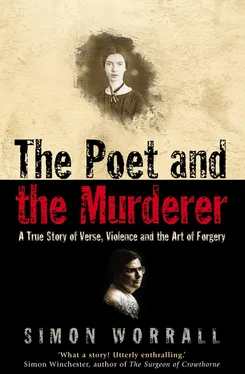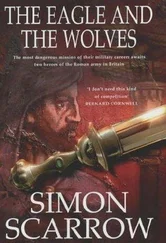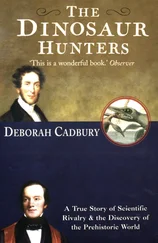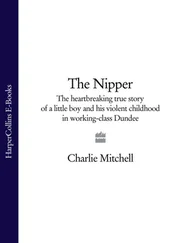The poem was listed in the Sotheby’s catalog between a rare 1887 edition of Charles Dickens’s Pickwick Papers , bound in green Morocco leather, and an original watercolor cartoon of Mickey Mouse and Pluto. The catalog described it as an ‘autograph poetical manuscript signed (“Emily”).’ The juxtaposition with Mickey Mouse would have delighted Dickinson, thought Lombardo, as he took out an Amarelline liquorice from the tin he had brought back from a recent trip to Sicily and settled back to read the poem.
It was written in pencil, on a piece of blue-lined paper measuring eight by five inches. On the top left corner was an embossed insignia. And the poem was signed ‘Emily.’ In red ink, at the top right corner of a blank page attached to the poem, someone had also written, ‘Aunt Emily,’ in an unidentified hand:
That God cannot
be understood
Everyone agrees
We do not know
His motives nor
Comprehend his
Deeds –
Then why should I
Seek solace in
What I cannot
Know?
Better to play
In winter’s sun
Than to fear the
Snow
With his elfin features, bushy, russet-brown beard, and shoulder-length hair, Dan Lombardo looks like one of the characters in Tolkien’s The Hobbit . He weighs one hundred pounds and stands five feet two inches tall. Getting up from his desk, he walked over to the imposing, cupboardlike safe standing in the corner of his office. It was taller than he was, made of four-inch-thick steel, and had a combination that only he and the library’s director knew. Inside it were manuscripts worth hundreds of thousands of dollars. Spinning the wheels of the combination lock until the door clicked open, Lombardo took out several Dickinson manuscripts and laid them on his desk.
One was a letter from 1871. The other was a poem called ‘A Little Madness in the Spring,’ which Dickinson had sent to a friend, Elizabeth Holland, in 1875. Written on the same kind of notepaper, in a similar hand, it bore an uncanny resemblance to the poem in the Sotheby’s catalog. It was even written in pencil and signed ‘Emily’:
A little Madness in the Spring
Is wholesome even for the King
But God be with the Clown –
Who ponders this tremendous scene –
This whole Experiment of Green –
As if it were his own!
Lombardo compared the handwriting. Emily Dickinson’s handwriting changed radically during her lifetime. Yet the handwriting from within each period of her life is generally consistent. Lombardo was not an expert, but the handwriting in both poems looked the same. The tone and content of the poems seemed similar as well. The high-water mark of Dickinson’s poetry had been reached the decade before. By the 1870s the flood of creativity that had given the world some of the most heart-powerful and controlled poems ever written in the English language had begun to recede. Dickinson was in her forties. Her eyesight was failing. Her creative powers were declining. Many poems from this period are just such minor ‘wisdom pieces’ as this one seemed to be.
The fact that the poem was signed on the back ‘Aunt Emily’ suggested to Lombardo that it had been written for a child, most probably Ned Dickinson, the poet’s nephew. In 1871 Ned would have been ten years old. He lived next door to her at the Evergreens, and Dickinson, who never had children of her own, adored him. The feeling seems to have been reciprocated. Ned frequently ran across from the Evergreens to visit his brilliant, eccentric aunt. On one occasion he left his rubber boots behind. Dickinson sent them back on a silver tray, their tops stuffed with flowers.
Perhaps this new poem was a similar gesture, thought Lombardo. He knew she had sent Ned other poems that playfully questioned religious beliefs, like one sent him in 1882. It was also written in pencil and signed ‘Emily’:
The Bible is an antique Volume –
Written by faded Men
At the suggestion of Holy Spectres –
Subjects – Bethlehem –
Eden – the ancient Homestead –
Satan – the Brigadier –
Judas – the Great Defaulter –
David – the Troubadour –
Sin – a distinguished Precipice
Others must resist –
Boys that ‘believe’ are very lonesome –
Other Boys are ‘lost’ –
Had but the Tale a warbling Teller –
All the Boys would come –
Orpheu’s Sermon captivated –
It did not condemn.
The possibility that it had been sent to a child added to the poem’s charm. The image many people had of Dickinson was of a lonely, rather severe New England spinster who spent her life immured in the Homestead, under self-elected house arrest; the quintessential artistic genius, driven by her inner demons. It was how the public liked its artists. The poem showed another side to her that Lombardo felt was more truthful. Instead of the Isolata of legend, she appears as a witty, affectionate aunt sending a few quickly scribbled lines of verse across the hedge to her adored nephew.
Lombardo was particularly excited by the new poem because, although the Jones Library had a fine selection of manuscripts by another former resident of Amherst, Robert Frost, including the original of ‘Stopping by Woods on a Snowy Evening,’ it had only a few manuscripts by the town’s most famous daughter. Almost all of Emily Dickinson’s letters and poems are at two far wealthier institutions: Amherst College, and the Houghton Library at Harvard University. Since becoming curator of Special Collections in 1982, Lombardo had devoted himself to building up the Jones Library’s collection of her manuscripts. The chance to buy a poem that the world had never seen was a unique opportunity.
After looking at the handwriting Lombardo did a cursory check of the paper. For this he consulted the classic two-volume work The Manuscript Books of Emily Dickinson , by Ralph Franklin, a Yale University scholar widely regarded as the world’s foremost expert on Dickinson’s manuscripts. The poem in the Sotheby’s catalog was written on Congress paper, which was manufactured in Boston. It was lined in blue and had an image of the Capitol embossed in the upper left-hand corner. According to Franklin’s book Dickinson had used Congress paper at two different periods in her life: once in 1871, and again in 1874. The poem in the Sotheby’s catalog was dated 1871. Lombardo told himself that it was absurd to think of buying the poem. The Sotheby’s estimate for the poem was $10,000–$ 15,000. But Lombardo was sure this would climb to as much as $20,000. The Jones Library had only $5,000. But in the days that followed, he became more and more excited at the prospect of acquiring the poem. He felt strongly that Dickinson’s works belonged in the town where she had created them. As William and Dorothy Wordsworth are to Grasmere, in England, or Petrarch is to Vaucluse, in France, Emily Dickinson is to Amherst: an object of pride and an industry. Each year thousands of Dickinson’s fans, from as far away as Japan and Chile, make the pilgrimage to the Homestead. Cafés offer tins of gingerbread baked to her original recipe. Scholars fill the town’s bed-and-breakfasts and patronize its restaurants. The poet’s grave is always decked with flowers.
Some years earlier Lombardo had had the idea of throwing a birthday party for Dickinson. On December 10 children from the town and surrounding area were invited to the Jones Library to wish the poet many happy returns and play games like ‘Teapot’ and ‘Thus Says the Mufti,’ which Dickinson herself played as a child. Dressed in period clothes – a top hat, burgundy-colored waistcoat, and leather riding boots – Lombardo would tell the children about the poet’s life, and how it connected to the town.
Читать дальше












